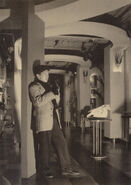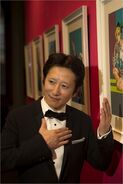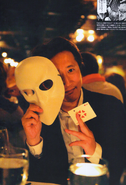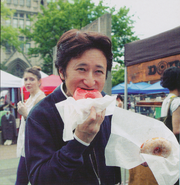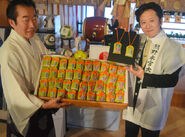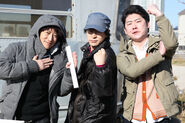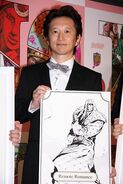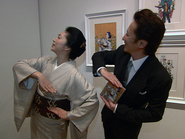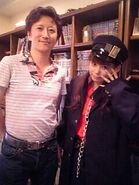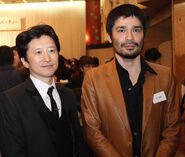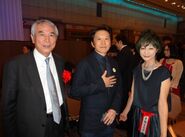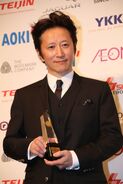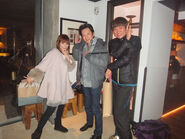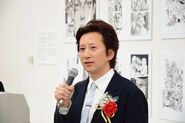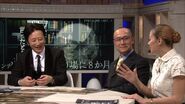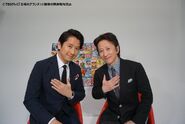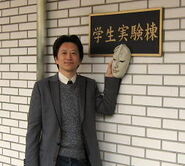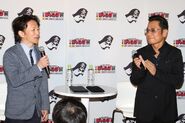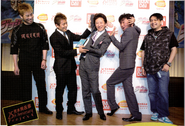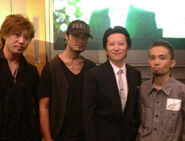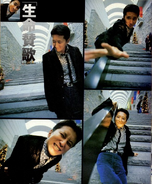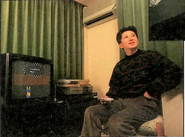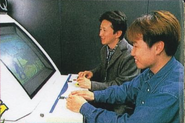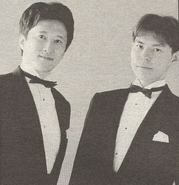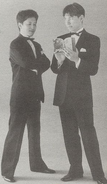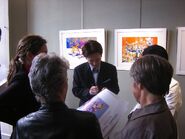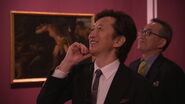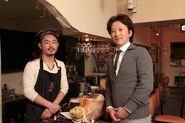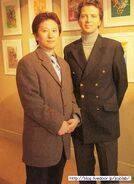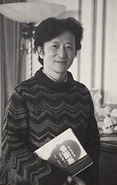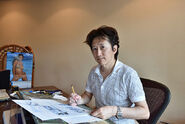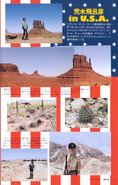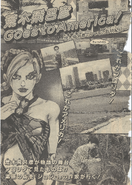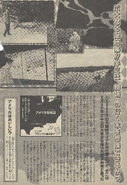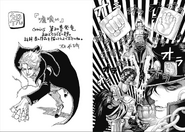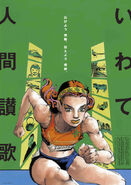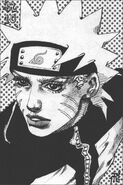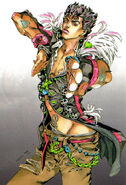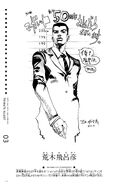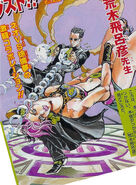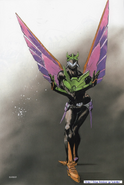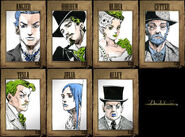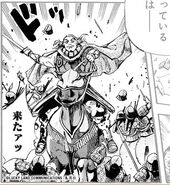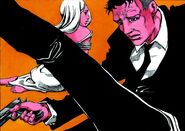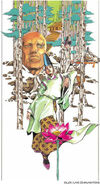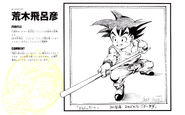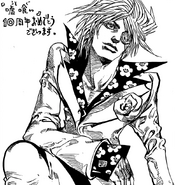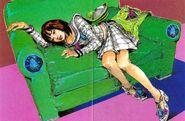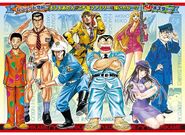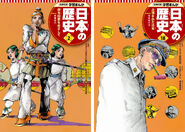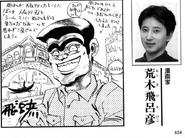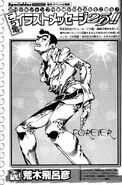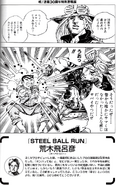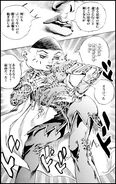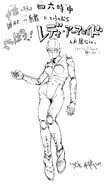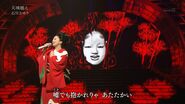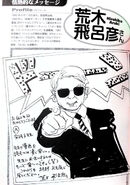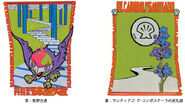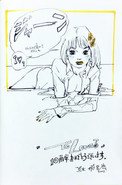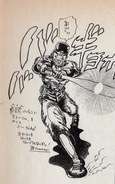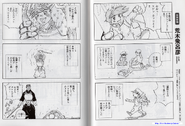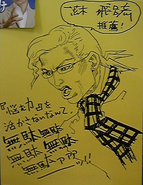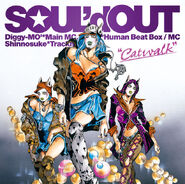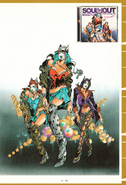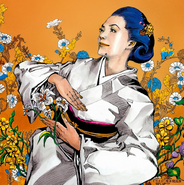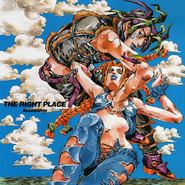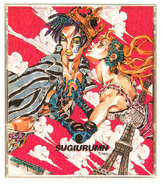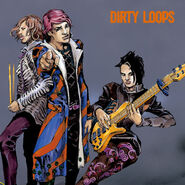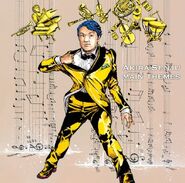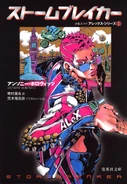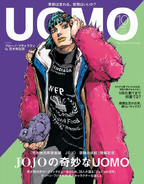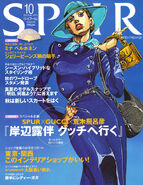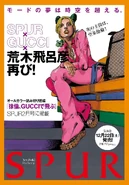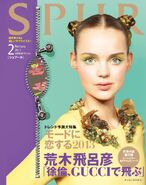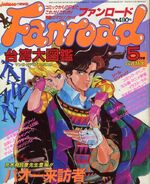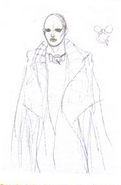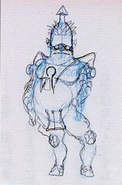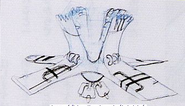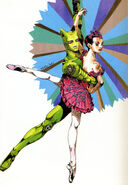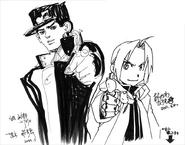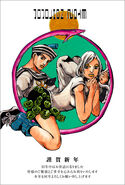| “ | I'd say living with a positive outlook is the theme of JoJo. It's a celebration of humanity. | ” |
—Hirohiko Araki | ||
Hirohiko Araki (荒木 飛呂彦 Araki Hirohiko, born June 7, 1960 in Sendai, Miyagi[3]) is a mangaka and author of JoJo's Bizarre Adventure, on which this wikia project is based. He made his debut under the name Toshiyuki Araki (荒木 利之 Araki Toshiyuki) in 1980 with his one-shot Poker Under Arms, and began his professional career with the short series Cool Shock B.T., Baoh, and Gorgeous Irene.
His work on JoJo's Bizarre Adventure is divided into several parts and continues to be serialized for 30 years, totaling 122 volumes (as of December 2018), circulating over 90 million copies (Sep 2014).[4] His style has been described as an "experimental, but definitive approach.[5][6]"
Works
- See also: Release Timeline

A cover of Weekly Shonen Jump featuring Araki's JoJo's Bizarre Adventure.
Manga
- Poker Under Arms (武装ポーカー Busō Pōkā, 1980)
- Outlaw Man (アウトロー・マン Autorō Man, 1981)
- Say Hi to Virginia (バージニアによろしく Bājinia ni Yoroshiku, 1982)
- Cool Shock B.T." (魔少年ビーティー Mashōnen Bī Tī, October 23, 1982–November 22, 1983)
- Baoh: The Visitor (バオー来訪者 Baō Raihōsha, October 9, 1984 – February 12, 1985)
- Gorgeous Irene (ゴージャス☆アイリン Gōjasu Airin, 1985–1986)
- JoJo's Bizarre Adventure (December 2, 1986–ongoing)
- The Lives of Eccentrics (変人偏屈列伝 Henjin Henkutsu Retsuden, 1989–2003)
- Under Execution Under Jailbreak (死刑執行中脱獄進行中 Shikei Shikkōchū Datsugoku Shinkōchū, December 28, 1994)
- Dolce and His Master (ドルチ ~ダイ・ハード・ザ・キャット~ Doruchi Dai Hādo Za Kyatto, 1996)
- Thus Spoke Kishibe Rohan (岸辺露伴は動かない Kishibe Rohan wa Ugokanai, June 24, 1997–ongoing)
- Dead Man's Questions (デッドマンズQ Deddomanzu Kuesuchonzu, June 2, 1999–July 7, 1999)
- Oingo Boingo Brothers Adventure (オインゴとボインゴ兄弟 大冒険 Oingo to Boingo Kyōdai Daibōken, October 23, 2002)
- Rohan at the Louvre (岸辺露伴 ルーヴルへ行く Kishibe Rohan Rūvuru e Iku, April 8, 2010)
- Rohan Kishibe Goes to Gucci (岸辺露伴 グッチへ行く Kishibe Rohan Gutchi e Iku, August 23, 2011)
- Jolyne, Fly High with GUCCI (徐倫、GUCCIで飛ぶ Jorīn, Gutchi de Tobu, December 22, 2012)
Other
- Famicom Jump II: Saikyo no Shichinin (February 1991, seventh boss monster design)
- Kamedas (1993, an alternate story of Kochira Katsushika-ku Kameari Kōen-mae HashutsujoW, an illustration)
- JoJo's Bizarre Adventure (novel) (November 4, 1993, novel written by Mayori Sekijima and Hiroshi Yamaguchi, illustrated by Araki)
- JoJo6251 (December 10, 1993, art and guidebook)
- JOJO A-GO!GO! (February 25, 2000, artbook)
- Music is the Key of Life (December 13, 2000, album by Sugiurumn, cover illustration)
- GioGio's Bizarre Adventure 2: Golden Heart, Golden Ring (May 28, 2001, novel written by Gichi Ōtsuka and Tarō Miyashō, supervised and illustrated by Araki)
- Life Ground Music (February 27, 2002, album by Sugiurumn, cover illustration)
- Alex RiderW Series (女王陛下の少年スパイ!アレックス) (2002-2007, cover illustration)
- StormbreakerW (novel, illustrations for Fantasy PressW)
- Kochira Katsushika-ku Kameari Kōen-mae HashutsujoW (2006, 30th anniversary special illustration)
- "Catwalk" (April 26, 2006, single by SOUL'd OUTW, cover illustration)
- UniqloW (2006, T-shirt design)
- Fist of the North StarW (2006, special tribute illustration in Weekly Comic Bunch)
- CellW (September 7, 2007, front cover illustration)
- The Book: JoJo's Bizarre Adventure 4th Another Day (November 26, 2007, novel written by Otsuichi, supervised and illustrated by Araki)
- The Dancing Girl of IzuW (2008, cover illustration)
- "Breeeeze Girl" (June 24, 2009, a single by Base Ball BearW, cover illustration of the limited edition)
- NarutoW (2009, 10th anniversary special illustration)
- Hirohiko Araki's Super-Favorites! Rules of Movies (荒木飛呂彦の超偏愛! 映画の掟 Araki Hirohiko no Chō Hen'ai! Eiga no Okite, May 17, 2011)
- Hirohiko Araki's Bizarre Horror Movie Analysis (荒木飛呂彦の奇妙なホラー映画論 Araki Hirohiko no Kimyō na Hora Eiga Ron, June 17, 2011)
- Purple Haze Feedback (September 16, 2011, novel written by Kouhei KadonoW, illustrated by Araki)
- JoJo's Bizarre Adventure Over Heaven (December 16, 2011, novel written by Nisio IsinW, cover illustration)
- Lacan for Survival (生き延びるためのラカン Ikinobiru Tame no Rakan, 2012, Tamaki Saitō'sW book about Jacques LacanW, cover of the paperback edition)[7]
- Jorge Joestar (September 19, 2012, novel written by Ōtarō MaijōW, illustrated by Araki)
- X -Cross-W (September 19, 2012, an album by Sayuri IshikawaW, cover illustration)
- HIROHIKO ARAKI WORKS 1981-2012 (2012, artbook)
- JOJOmenon (October 5, 2012, artbook)
- JOJOVELLER (September 19, 2013, artbook set)
- JoJonium (December 4, 2013 - March 4, 2015, covers of the large format re-release of JoJo's Bizarre Adventure)
- Main Themes (February 25, 2015, an album by Akira SenjuW, cover illustration)
- Hirohiko Araki's Manga Technique (荒木飛呂彦の漫画術 Araki Hirohiko no Manga Jutsu, April 17, 2015)
Personal life
Araki is often commented on for his unchanging youthful demeanor over the years. He cites training and swimming at the gym and Hitomebore rice as methods for staying fit while over the age of 50.[8] In his 2007 Eureka Interview, he is complimented by Japanese psychologist and critic, Tamaki Saito, but states that the main reason he switched to a monthly serialization was from no longer being able to handle the weekly schedule.[9]
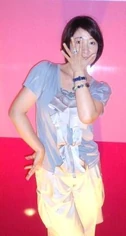
Araki's wife, Asami
Araki is well known for his position on staying healthy. He enjoys going on walks and riding a bike, particularly to Japanese shrines, and has commended it as his coping mechanism when exhausted from work. He considers exercise as a great way to discipline one's self and that carrying too many things can be a burden; Araki will typically only carry a coat, water, and an iPod when going out.[10]
This section requires expansion.
Family
Married to Asami Araki (荒木麻美 Araki Asami, nickname Chami), Araki is the father of two girls. A couple years after his debut, Araki met Asami in a group meet-up, and the two got married three months later.[11]
Biography
Araki grew up in Sendai, Japan with his parents and younger identical twin sisters. He cites his sisters' annoyances as the reason he spent time alone in his room reading classic manga from the '70s, such as Ai to MakotoW, and his father's collection of art books, which Araki assumes informed his motive for drawing manga.[12] He was particularly influenced by the work of French artist Paul GauguinW.[13]
Araki drew his very first manga while he was in 4th grade. He attended a prep school through junior high and high school, which was where a friend complimented him on a manga he drew for the first time. Ever since, he began to draw manga in secret of his parents.[12]
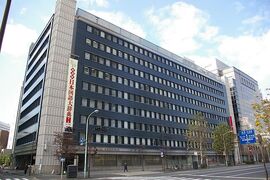
Shogakukan (left) and Shueisha (far right) HQs.
He began submitting work to publishers during his first year of high school; however, all of his submissions were rejected.[12] At the same time, others artists who were around his age continued to make big splashes with their debuts (Ex: Yudetamago, Masakazu Katsura). Araki could not understand why he was being rejected, so he decided to finish off a submission on an all-nighter, go on a 4-hour trip to pay a visit to the editors in Tokyo, and ask them for an explanation. At first he intended to visit Shogakukan, which published Weekly Shōnen SundayW, but he was intimidated by the size of their building, and decided to take his submission into the smaller Shueisha (Publishers of Weekly Shonen Jump) building next door. It was noon when he visited, but one rookie editor (about 6'2", or 185 cm, tall) happened to be there. The editor, after reading the first page, promptly quipped "your white-out's leaked (You haven't fixed it)": he was criticized every time the editor flipped through each page. Araki, exhausted from having been up all night, felt like he was going to pass out, but was told to fix it up for the Tezuka Awards in 5 days. That submission was "Poker Under Arms", which won the runner up prize at the Tezuka Awards.[12][14]
Araki left Miyagi University of EducationW before graduating, and made his debut in 1980 with the aformentioned one-shot Poker Under Arms. His first serialization in Weekly Shonen Jump was Cool Shock B.T. in 1983,[14] with his works Baoh: The Visitor (1984) and Gorgeous Irene (1984) following soon after. His next series would become his magnum opusW, 1986's JoJo's Bizarre Adventure.
JoJo's Bizarre Adventure
- Main article: JoJo's Bizarre Adventure
Published in Weekly Shonen Jump between 1987 and 2004 and from 2004 to the present in Ultra Jump, JoJo's Bizarre Adventure represents Hirohiko Araki's primary brand and body of work.This section requires expansion.
The dust jacket of every volume of JoJo contains a note to the reader; a relatively great source of Araki's direct opinions.
Style and Influences
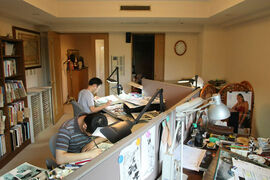
Araki's studio - own desk in foreground
Araki's drawing commonly involves idealized figures in broad, expressive poses at adventurous scales and angles; with sharply inked lines and scattered, blackened planes; lending them a sculptural effect. In color illustrations and pages, Araki varies roughly complementary color juxtapositions.
In terms of cartooning, a comparison can be drawn between Phantom Blood, Battle Tendency, and Stardust Crusaders (1987 - '92) and the hypermasculine (and highly dimorphic) anatomical ideals applied by Tetsuo Hara in Fist of the North Star, and referenced by Araki in relation to action heroes of the 1980s.[15] Diamond is Unbreakable ('92 - '96) marks a transition to a more intersexual model; while Steel Ball Run (2004 - '11) sees greater realism, along with further incorporation of ideals of beauty consistent with the mode in fashion design.
Reference to illustrations by artists including Antonio Lopez and Tony Viramontes informs a number of individual illustrations and character poses in Araki's work from 1987 - 1992; decreasing from then along with increased use of photographic references.[16] Limited examples of costumes borrowed from contemporary fashion design have been identified.
As a film fan, In the 1980s Araki noted the popularity of action movies and the muscular physiques characteristic of their stars (such as Arnold Schwarzenegger and Sylvester Stallone). By this example, Araki would ponder; "Who is the strongest person in the world?". Subjects such as immortality and justice occurred to him as things that humans innately value and seek. Araki had also been on a trip to Italy two years prior to the creation of Part 1: Phantom Blood, where he identified the exaltation of overt human beauty characteristic of renaissance art. Araki would combine these examples in the formulation of the basic plot and visual style of Phantom Blood.[15]
Araki has named Paul Gauguin and his approach to color theory as an influence.[17]
Araki has described his drawing method as "classical".[15] He has indicated admiration for Leonardo da Vinci in the text of the manga and otherwise; and in a video feature in JOJOVELLER, he is seen making visual reference to a book of Michelangelo's work[18] during the construction of a piece.
Manga that Araki has named as admirable or having had particular influence on him include Ai to Makoto by Ikki Kajiwara and Takumi Nagayasu, the most significant of his youth;[19] Ore wa Teppei by Tetsuya Chiba, which inspired him while in middle school to join the kendo club;[19] and Babel II by Mitsuteru Yokoyama, particularly influential for the concept of combat defined by special rules or laws.[15]
Araki has authored a book on the subject of Horror film and its influence on his work.
Araki has described his habit of naming characters and Stands after musicians and their works as "a simple hobby", and has indicated a strong preference for Western popular music.
Araki's Lists
Hirohiko Araki's Best 10 Characters - Author's Popularity Contest (作者人気投票キャラクターベスト10) from JOJO A-GO!GO! (2000) - Araki Hirohiko, p. 75
| No. | Character |
|---|---|
| 1 | Josuke Higashikata (東方 仗助) |
| 2 | Yoshikage Kira (吉良 吉影) |
| 3 | Bruno Bucciarati (ブローノ・ブチャラティ) |
| 4 | Vinegar Doppio & Diavolo (ドッピオとディアボロ) |
| 5 | Giorno Giovanna (ジョルノ・ジョバァーナ) |
| 6 | Joseph Joestar (ジョセフ・ジョースター) |
| 7 | Guido Mista (グイード・ミスタ) |
| 8 | Jotaro Kujo (空条 承太郎) |
| 9 | Shigekiyo Yangu (矢安宮 重清) |
| 10 | DIO (DIO) |
"Hirohiko Araki's Favorite Illustrations Best 20" from JOJO A-GO!GO! (2000) - Araki Hirohiko, pp. 52–57 <gallery> Volume 7.jpg Chapter 57.jpg Volume 9.jpg Chapter 157 Cover B.jpg Volume 17.jpg Volume 25.jpg Chapter 146 Cover B.jpg Chapter 253 Cover B.jpg Jotarokujo2.png Jjbadramacd2.jpg Volume 27.jpg Volume 24.jpg Chapter 301 Cover B.jpg Volume 31.jpg Volume 34.jpg Chapter 496 Magazine Cover B.jpg Volume 50.jpg Volume 56.jpg Volume 61.jpg
Volume 63.jpg
Araki's Best 10 "Ran to the bookstore" Manga (本屋に走ったマンガベスト10) from JOJO A-GO!GO! (2000) - Araki Hirohiko, p. 74
| No. | Comic |
|---|---|
| 1 | Golgo 13W: Serizawa Family Murder Case (ゴルゴ13芹沢家殺人事件) |
| 2 | Nijioyobu Ken (虹をよぶ拳) |
| 3 | Space Battleship YamatoW (宇宙戦艦ヤマト) (Anime) |
| 4 | Dragon BallW (ドラゴンボール) |
| 5 | Kōya no Shōnen IsamuW (荒野の少年イサム) |
| 6 | DororoW (どろろ) (Anime) |
| 7 | Tobaku Mokushiroku KaijiW (賭博黙示録カイジ) |
| 8 | Babel IIW (バビル2世) |
| 9 | Naniwa Kin'yūdōW (ナニワ金融道) |
| 10 | Fist of the North StarW (北斗の拳) |
"Araki's Favorite: Best Stands" from JOJO A-GO!GO! (2000) - STANDS, pp. 34–36
Design
| No. | Stand |
|---|---|
| 1 | Gold Experience |
| 2 | Killer Queen |
| 3 | Echoes |
Function
| No. | Stand |
|---|---|
| 1 | Pearl Jam |
| 2 | The Grateful Dead |
| 3 | Killer Queen Bites the Dust |
Total
| No. | Stand |
|---|---|
| 1 | Crazy Diamond |
| 2 | Sex Pistols |
| 3 | Sticky Fingers |
Araki's Most Watched Films - Best 10 (くり返し観た映画ベスト10!) from JOJO A-GO!GO! (2000) - Araki Hirohiko, p. 72
| No. | Film |
|---|---|
| 1 | Great Escape |
| 2 | Jaws |
| 3 | Zombie (Dawn of the Dead) |
| 4 | The God Father I,II,III |
| 5 | Dirty Harry |
| 6 | It Happened One Night |
| 7 | Fargo |
| 8 | Back to the Future |
| 9 | Dog Day Afternoon |
| 10 | Misery |
ARAKI'S BEST 20 SUSPENSE FILMS from Hirohiko Araki's Super-Favorites! Rules of Movies (2013)
| No. | Film |
|---|---|
| 1 | Heat |
| 2 | The Great Escape |
| 3 | Taken |
| 4 | Mystic River |
| 5 | The Unforgiven |
| 6 | Psycho |
| 7 | Heaven Can Wait |
| 8 | Shrek |
| 9 | Fargo |
| 10 | Dirty Harry |
| 11 | The Bourne Identity |
| 12 | City of God |
| 13 | Duel |
| 14 | Eyes Wide Shut |
| 15 | The Butterfly Effect |
| 16 | Master and Commander: The Far Side of the World |
| 17 | Unfaithful |
| 18 | Frost/Nixon |
| 19 | Pound |
| 20 | Witness |
| 21 | Reservoir Dogs (Runner-Up) |
Araki's top 5 favorite toys from Volume 60 Author's Note
| No. | Toy | Comment |
|---|---|---|
| 1 | Phosphorescent skeleton | (When it shines at night, it feels like I'm in a fairy tale.) |
| 2 | Bouncing ball | (This piece of rubber took me into a science-fiction universe.) |
| 3 | Resident Evil | (Playstation) (It's so great!) |
| 4 | A Thunderbird II model | (I love the design and I find that the container's conception was very clever! I really had the impression I could go anywhere with this.) |
| 5 | Lego or Mega Bloks | (I spent whole days assembling and disassembling the piece to make new models. I think that Lego is the Western philosophy in its entirety.) |
Araki Hirohiko's Top 10 "That's fucking scary" Movie List. (The ones where you say "NO! Make it stop!" But you watch it anyway) (From the Author's Note in Volume 32)
| No. | Film |
|---|---|
| 1 | The Night of the Living Dead |
| 2 | Jaws |
| 3 | Johnny Got His Gun |
| 4 | Mississippi Burning |
| 5 | Platoon |
| 6 | Papillon |
| 7 | Halloween 4 |
| 8 | Lord of the Flies |
| 9 | Silence of the Lambs |
| 10 | Alien |
The "Best 20 Horror movies chosen by Hirohiko Araki" (From Hirohiko Araki's Bizarre Horror Movie Analysis)
| No. | Film |
|---|---|
| 1 | Zombie (‘78 director’s cut) |
| 2 | Jaws |
| 3 | Misery |
| 4 | I Am Legend |
| 5 | Ninth Gate |
| 6 | Alien |
| 7 | Ring (TV version) |
| 8 | The Mist |
| 9 | Final Destination |
| 10 | The Texas Chainsaw Massacre |
| 11 | Dasshutsu |
| 12 | The Blob |
| 13 | 28 Days Later |
| 14 | Basket Case |
| 15 | Sleeping With The Enemy |
| 16 | No Country |
| 17 | The Exorcist |
| 18 | Funny Games (‘07 US remake) |
| 19 | Hostel |
| 20 | Kuraimori |
Araki's song choices for the "Back to 80s" Western Music Hits Parade on MTV Japan
| No. | Artist | Song |
|---|---|---|
| 1 | GUNS N' ROSES | Welcome to the jungle |
| 2 | ZZ TOPS | Legs |
| 3 | DIRE STRAITS | Money for nothing |
| 4 | MICHAEL JACKSON | Thriller |
| 5 | UB40 | Red red wine |
| 6 | BRUCE SPRINGSTEEN | Dancing in the dark |
| 7 | U2 | I still haven't found what I'm looking for |
| 8 | DONALD FAGEN | New Frontier |
| 9 | THE STYLE COUNCIL | Shout to the top |
| 10 | SADE | Smooth Operator |
| 11 | PRINCE | When doves cry |
| 12 | DAVID LEE ROTH | California Girls |
The Best 10 Painful Songs (せつない曲ベスト10) from JOJO A-GO!GO! (2000) - Araki Hirohiko
| No. | Artist | Song |
|---|---|---|
| 1 | Chicago | Wishing You Were Here |
| 2 | Eagles | Hotel California |
| 3 | Vladimir Ashkenazy | Mozart's Piano Concerto No. 20 |
| 4 | Carpenters | Superstar |
| 5 | Miles Davis | Blue in Green |
| 6 | Nino Rota | Plein soleil |
| 7 | The Beatles | And I Love Her |
| 8 | Shawn Colvin | Wichita Skyline |
| 9 | Eric Clapton ft. Babyface | Change the World |
| 10 | The Stylistics | Only you |
Araki's Top 10 "Albums that make me cry"
| “ | These are my top 10 from the 70s, in no particular order. You might love them or hate them but I guarantee if you listen to them you'll cry. | ” |
| Artist | Album |
|---|---|
| Led Zeppelin | Physical Graffiti |
| Chicago | Chicago VII |
| Various | Saturday Night Fever |
| Curtis Mayfield | Superfly |
| Marvin Gaye | What's going on |
| Jackson Brownie | Late for the sky |
| Pink Floyd | Dark Side of the Moon |
| Sex Pistols | Never mind the Bollocks |
| George Benson | Breezin |
| Carpenters | Now & Then |
Hirohiko Araki's All-time Best 10 Clint Eastwood Films (荒木飛呂彦が選ぶイーストウッド作品オールタイムベスト 10) from JOJOmenon. They are not in any specific order.
| Films |
|---|
| The Good, the Bad and the Ugly |
| Play Misty for Me |
| Dirty Harry |
| Escape from Alcatraz |
| Firefox |
| Unforgiven |
| Mystic River |
| Changeling |
| Gran Torino |
| J. Edgar |
Araki's Top 10 Heroes (ヒーロー) from JOJO A-GO!GO! (2000) - Araki Hirohiko
Described as Araki's inspirations; those with the courage to innovate when it came to design or fashion. They are not in any specific order.
| Heroes |
|---|
| Leonardo Da Vinci |
| Velázquez |
| Christian Dior |
| Giotto |
| Paul Gauguin |
| Auguste Rodin |
| Antonio Lopez |
| Gianni Versace |
| Bob Peak |
| Pablo Picasso |
Gallery
Artist Photos
Tributes
Album Covers
Novels
Alex Rider
Magazine Covers
Sketches & Concept Art
Other
Trivia
- Araki's favorite book as a kid was The Adventures of Sherlock HolmesW.[2]
- In 2012, Araki celebrated his 30th year as a manga artist and the 25th anniversary of JoJo’s Bizarre Adventure. A special exhibition was held in Sendai, Japan, which included the announcement for the TV Anime and All Star Battle.
- On November 30, 2016, Araki won the 45th Annual Best Dresser Awards in Tokyo in the "Academic and Cultural Arts" division. When questioned about his youthful appearance, Araki said that he washes his face every morning with Tokyo's tap water.[20]
References
| This page uses Creative Commons Licensed content from Wikipedia (view authors). |
| Shueisha | |
|---|---|


